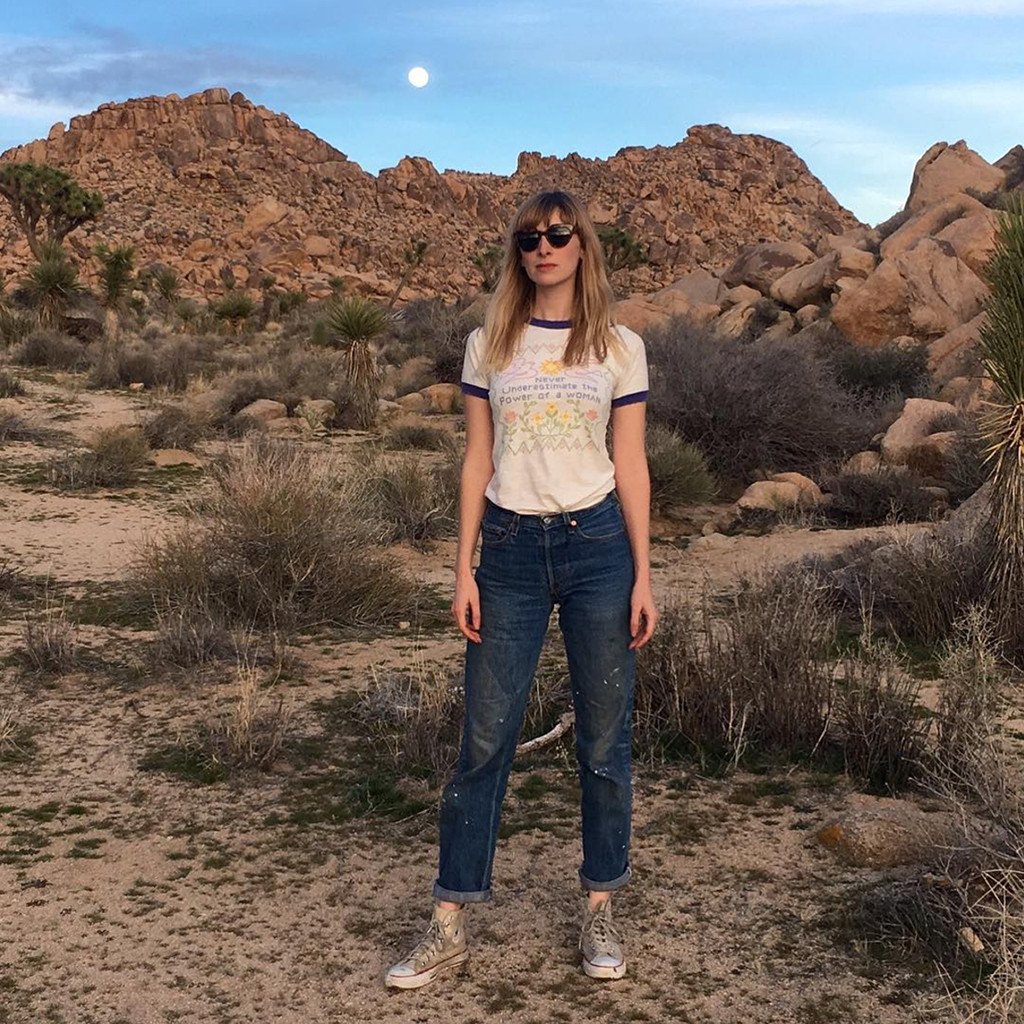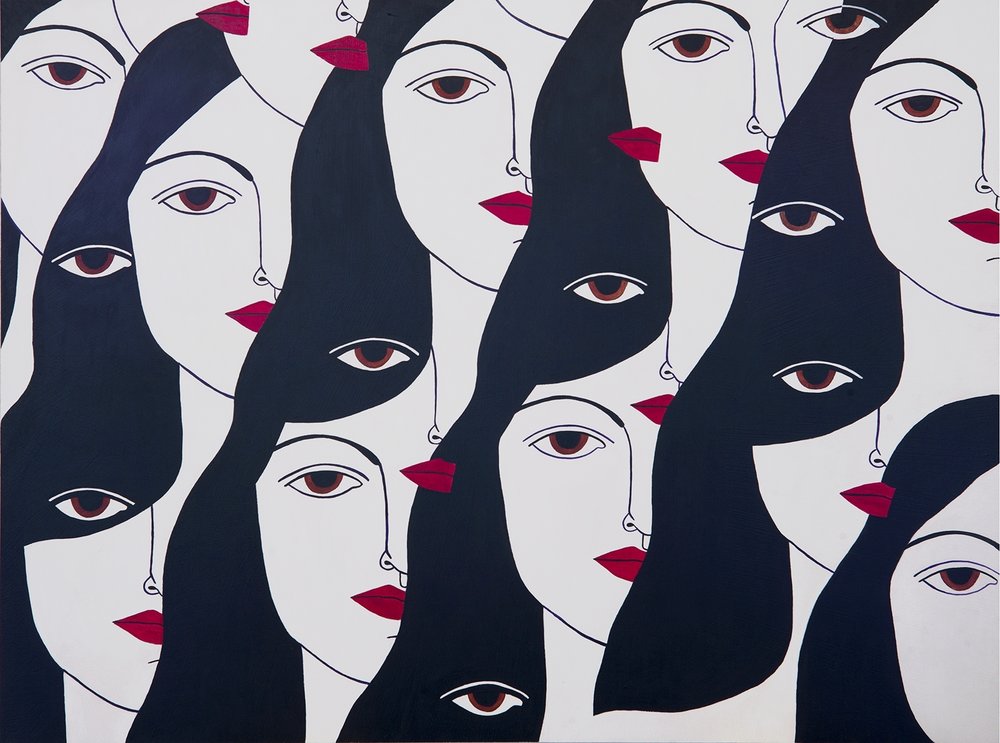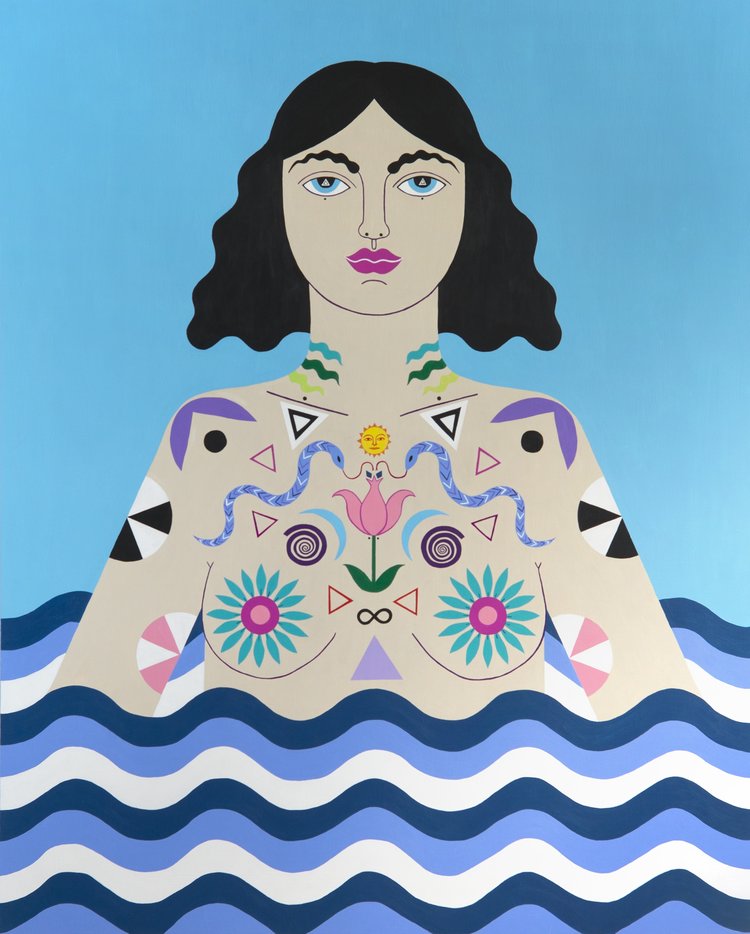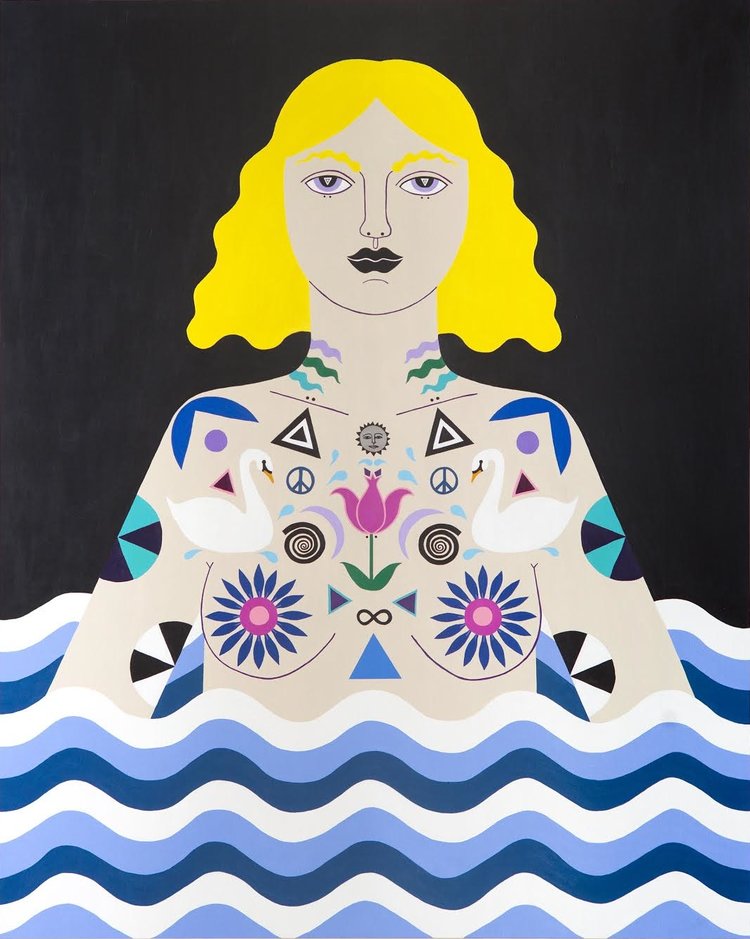TALKING TO THE PEOPLE YOU PASS EVERYDAY: Caris Reid
Lunar Baedeker, Caris Reid
48 x 36 inches. Acrylic on Wood. 2016
Prologue : Writing About Art
I don't often write about art because I got so burnt out in the American higher education system. I never understood why I would spend so much money on becoming an expert on other people's thoughts about other people's work.
When we are children we are asked our favorite color, and no one asks why. Maybe we become attached to a shirt or a color that we wear obsessively as a security blanket. No one asks why. As we become adults we are afforded the privilege of asking ourselves the question of why, but also bear the suffocating burden that others will expect us to answer this question for them.
I still believe that when we look at a piece of art, we can like it the way that we like a leaf as a kid or a sunset as an adult. We recognize and behold that it is beautiful as it touches something preverbal and personal, but also has the potential to shift our cerebral world, to engage the workings of our mind, to inspire us to ask ourselves questions.
As a dear stylist friend once said while we were doing catalog, "It's a feeling."
Caris Reid, Former Graham Stop Dweller, Current Joshua Tree Resident
“ The symbols and sigils that are chosen for each painting is very intuitive. Some of the symbols have very specific personal meanings, others are commonplace, and some are more obscure. I want them to speak to the part of our brain that is beyond reason.-”
I met Caris Reid when I opened my store almost three years ago. She was wearing this brighter-than-cherries red soft wool coat. We got to talking and I discovered she was a painter. Here in Brooklyn, there's something really intimidating about meeting artists for me. I don't actually remember asking her much more about her work at that time. We saw each other from time to time at the shop, I spotted her on the instagram feed of my friend Glenn Lovrich's (who is constantly evolving as a hairstylist) and at that time, she was still what she had always been. A face and a neighbor, a sweet conversation and a memory of a beautiful image she made for me in her red jacket.
Then I connected with her social media account and saw her work. I saw that she was in Joshua Tree (where I took the only "for me" vacation of my adult life at the age of 33), and because I feel so deeply drawn to that particular desert, I became really interested in what she was doing out there. I'm a lot less shy when there's a machine or a piece of media between me and another person, and in this particular case, social media created a bridge where an everyday interaction might have remained shallow between us, out of politeness, and the "rules" of living in a densely-populate place.
I began exploring Caris Reid’s imagery: her instagram, her paintings and the feeling of connection between us was immediate (for me.) The paintings that grabbed me were her most recent works at the time, all part of a show in LA at the OCHI Gallery entitled Healer. Feeler. Seer. Seen. She created all of the work in Joshua Tree, which is a relatively small desert town that houses a national park full of joshua trees, which are trees that look like they came from Dr. Seuss’s imagination, (and are rumoured to have inspired some of his work.) The town is a tourist destination, a “getaway” from Los Angeles, but for many of its permanent residents and visitors, it holds a beautiful spiritual significance.
With rainbow sunrises and sunsets, whipperwhirl sounds waking you in the mornings, the proximity of coyotes, snake and scorpions, and the commonplaceness of living off a dirt road, it brings a closeness to nature. There is deep quiet. A natural community (everyone seems to know everyone.) There are endless spaces to gaze upward at stars.It was in this space that Caris created the paintings in her show.
The women she paints have the sort of intrinsic power that could belong to any powerful woman: the extremely caring nurse, the ancient shamanic healer, the caretaking and life-changing school librarian. They are ordinary but also are goddesses. Are fierce but also soft. They are warriors but at peace. They look directly at you, through you, they see you. Maybe you're someone who needs to be seen, and it feels good. Maybe you're someone who wants to hide and it feels really uncomfortable. Maybe you're both of those people all of the time and that's the feeling you feel.
The female archetypes she paints use the bright colors of a childhood, a time of purity, of unchecked imagination and courage. The bold one-dimensional lines suit the idea of folkloric and ancient storytelling because these characters belong to a world that is different than the three-dimensional space we are all grounded in.. The one-dimensional world is the natural home to imagination. It is where the archetype, the collective unconscious, the seeds and symbols that we can intuitively understand reside before their tales become verbalized. (*In History of the Modern World, J.M. Roberts writes about all mammals’ ancestors having 2-D vision before they develop 3-D vision.)
One imagines each of the women depicted in the paintings exists in every culture, with every tradition having its own name and narrative, but that underneath she is fundamentally the same energy. The familiarity presents itself because it’s touching something in the memory of our DNA, and yet it’s unfamiliar because it sits at the edge of our subconscious.
This is the space of the cave painting. The discovery of someone else’s attempt to express and record what it means to be human at any point in time.
We are called in these paintings to ask ourselves what a powerful woman is. Is she aggressive, sometimes quiet? Does she weep with unabashed despair? Who are the archetypes in our own lives, our own blood lineage and nuclear families, in our communities and friendships, in our archetypes and cultural symbols who illuminate the qualities of feminine power? And how can we reshape these to be truer, more reflective of who we are and what we hold to be our own powers, talents, toughness and softness?
Caris is reiki attuned, and has a spiritual path that is easily felt in her work, as well as an sharp intellect that is quickly recognized if you read any of her interviews. If you want to know more about her and her process, I highly encourage checking out this beautiful interview on The Radder. You will learn so much about how meditation plays into her work, as well as how this work fits into the larger body of her work. But before you click, IF YOU CAN, let the paintings speak to you directly. See if your subconscious feels touched, feels spoken to. If you’re moved in a way you don’t care to explain.
Caris's Glossary of Terms can be found at the gallery link below.
Caris Reid’s Show SUB ROSA Sept 7 - Oct 8, Denny Gallery







